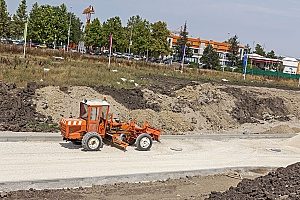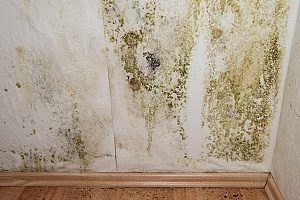Why Proper Site Grading Is Necessary
 Before construction begins, the construction site needs to be prepared. Site preparation can include tree and shrub clearing, removal of existing structures, rock and boulder removal, drainage correction, and grading. Site grading is more than just leveling or sloping the topsoil. It also involves stabilizing the subsoils underneath your construction site so that it will not collapse under the weight. If proper site grading is not completed, it won’t be long before your project has serious structural damage or foundation cracks.
Before construction begins, the construction site needs to be prepared. Site preparation can include tree and shrub clearing, removal of existing structures, rock and boulder removal, drainage correction, and grading. Site grading is more than just leveling or sloping the topsoil. It also involves stabilizing the subsoils underneath your construction site so that it will not collapse under the weight. If proper site grading is not completed, it won’t be long before your project has serious structural damage or foundation cracks.
Site grading requires first an analysis of the existing conditions of the site, including general flow of water, flow lines for surface runoff, existing structures, and vegetation. The engineer or contractor will determine if any contours need modification and make the necessary calculations required for slopes. It also requires an analysis of the development plans, that is, what structures will be built on the property. Site grading for an office building requires different considerations than a parking lot or roadway. Before construction begins, the site will be inspected to ensure it satisfies site plans and building codes.
A Summary of What Goes Into Proper Site Grading
Removing Vegetation and Rocks
You will need to stake out the foundations of the planned structure and facilities. Existing trees and shrubs need to be removed, but you probably won’t want to remove more than is necessary. Leaving vegetation improves aesthetics and lowers the cost of having the debris hauled away.
Any vegetation left in the ground beneath the structure will eventually decay, creating low spots that will sink and compromise the integrity of the project’s foundation. Rocks and boulders will eventually shift and cause cracks and weak areas in the foundation.
Rough Grading
Rough grading is the process of reaching the desired grade level for the project. In doing that, the contractor will try to balance the “cut and fill”. “Cut” is the ground area that is dug out, and “fill” is the dirt that is added. You will want to try to use the dirt that has been dug up somewhere else on the property to save the expense of hauling it away or bringing in more.
When the topsoil is scraped off, the contractor should set it aside to use as backfill for the foundation and on the surface when the project is completed. Topsoil is expensive, and it makes economic sense to save and use any that is taken up during grading.
During the rough grading stage, the contractor should try to bring it as close to finish grading as possible, using fill dirt to successfully complete the grading project.
Sloping and Erosion Control
 The site needs to be able to capture and drain storm water. If the property is too flat, surface and stormwater will pool and can flood the structures. If the property is too steep, the water can run off in destructive rivers. The site engineer and the grading contractor should follow established engineering formulas to establish the correct slopes necessary for the particular property conditions.
The site needs to be able to capture and drain storm water. If the property is too flat, surface and stormwater will pool and can flood the structures. If the property is too steep, the water can run off in destructive rivers. The site engineer and the grading contractor should follow established engineering formulas to establish the correct slopes necessary for the particular property conditions.
The goal of the engineer is to create a design consisting of strategically located high points to divert water (a crown) and low areas to channel the water (a swale). The best grading design will grade the site while minimizing site disturbances. It will change grades only where it is necessary. A site plan can be quite complex, involving sloping and cross-sloping without disturbing stream buffers and the canopies of the existing trees. Also, building codes and permits may require certain measures for erosion control. The site grading contractor will prepare the site for installation of those features. They may include conduit, retaining walls, rip rap, and so forth.
The goal of the grading contractor is to implement the engineer’s site plan. A complex site plan requires an experienced grading contractor to prepare the site according to the site plan.
Finish Grading
When the project construction is completed, the contractor will do the finishing touches necessary to bring the surface up to the final elevation, finish effective drainage patterns, correct erosion, and prepare for any landscaping.
During construction, the grading adjacent to the structure should be sloped away from the home. Problems can arise over time as the backfill around the foundation settles; the grading becomes flat to negative. The finish grading should be installed with enough slope that even after settlement, there is still positive grading away from the structure.
Bad Things Can Happen Due to Poor Site Grading
Ignoring the importance of good site grading will be expensive and can condemn the project. The property owner and the contractor can be held responsible for non-compliance and damage resulting from grading problems. Here is a description of just a few of the most common problems that improper site grading can create:
Water in the Basement
 When water infiltrates the basements or surface levels of a home or building, it is most often caused by the immediate grading and drainage around homes. Water infiltration can damage the building structure and cause health issues resulting from mold and fungus under structural basement floors or in the wall cavities of finished basements. This is why correctly using fill dirt during the grading process is critical for protecting your home from disasters such as water damage.
When water infiltrates the basements or surface levels of a home or building, it is most often caused by the immediate grading and drainage around homes. Water infiltration can damage the building structure and cause health issues resulting from mold and fungus under structural basement floors or in the wall cavities of finished basements. This is why correctly using fill dirt during the grading process is critical for protecting your home from disasters such as water damage.
Cracks in the Foundation
Cracks are evidence of water and/or settling. If the cracks get wider, you may have a drainage problem under the foundation. You need a structural engineer to diagnose the problem and recommend a solution.
Basement Wall Staining, Flaking or Efflorescence
This is another sign of moisture penetrating the foundation walls. It can be a sign of poor drainage around the foundation.
Contact a Professional Construction Contractor for More Information
Before you begin any construction, speak with a professional commercial construction contractor to discuss your project and site grading needs. They will schedule an appointment with you to evaluate the site, arrange professional site grading services, and any fill dirt delivery you may need.









































